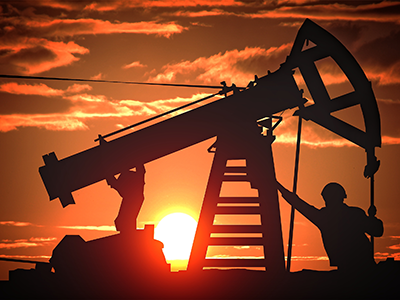Alberta budget forecast stuck on the oil roller-coaster

To no one’s surprise, Alberta did not slay the deficit dragon in its most recent budget. Or even introduce new weaponry for deficit slaying, or offer any new solutions to the problem.
Instead, the red ink has spread and the hope seems to be that black gold will one day wash it away. Alberta is leaning on its old standby — oil.
That finger-crossed approach to budgeting was immediately seized upon by opposition critics and economists alike.
“There are no plans to balance outside of oil prices,” said Ron Kneebone, an economist with the School of Public Policy at the University of Calgary.
“The only way out of it is to hope that oil prices come back to the 80, 90-dollar level, which no one seems to be expecting any time soon.”
Oilsands and the deficit
The Alberta government expects the production of conventional crude and natural gas to shrink in the coming years, but it is banking on oilsands production to increase by 32 per cent by 2020, from just under 2.5 million barrels per day in the current fiscal year to 3.3 million in 2019-20.
By then, the province is forecasting that crude oil will average $68 US per barrel, which is wildly optimistic according to the futures market, which sees oil trading around $50 US a barrel in 2020, but roughly in line with private sector forecasts.
Forecasting oil prices is tricky, of course, and research has shown that even experts aren’t that reliable.
- $100 oil in the forecast, according to commodity investment boss
- Oil prices to average about $55 a barrel in 2017, Deloitte forecasts
- Oil prices set to rise sharply, unless new projects are approved
“Expert guesses, the private sector forecast in the budget, that does worse than the current spot price or the futures price,” said Trevor Tombe, an associate professor of economics at the University of Calgary.
Tombe points out that if prices don’t recover much above $50 US a barrel, Alberta will run a $10-billion deficit indefinitely. Even if the budget is correct in its rosier assumptions, resource revenue will reach $6.6 billion in 2020. That’s lower than it was during the oil boom, but still the most significant revenue increase in the budget, and it accounts for much of the forecast reduction in the deficit between now and 2020.
As oil revenue goes up by $4.2 billion, the deficit goes down by $3.6 billion. Which still leaves a $7-billion hole to fill.
Can pipelines slay the deficit?
Which brings us to pipelines. Alberta’s budget didn’t offer specific deficit forecasts beyond 2020, but Joe Ceci, the province’s finance minister, did say that in six years, the budget of 2023-24 will be back in balance as the economy recovers and economic diversification takes hold. As well, the province is optimistic about what new pipeline capacity will mean for corporate and government revenue.
Both Enbridge’s Line 3 replacement and Kinder Morgan’s Trans Mountain expansion are estimated to be in operation in four to five years. Alberta Energy estimates that the extra pipeline capacity will allow Alberta producers to receive up to $7 more for each barrel of oil that they sell. That will spur billions in new investment in the province, which will lead to more production and $9 billion more in royalties to provincial government by the year 2022.
- Trudeau cabinet approves Trans Mountain, Line 3 pipelines, rejects Northern Gateway
- Will pipeline protests get lost amid the noise of the Trump era?
The National Energy Board suggested last year that Canadian producers would indeed get less per barrel if no new pipeline capacity is built out of Western Canada. The NEB suggested producers would have to pay as much as $10 extra per barrel to ship their oil by rail to the U.S. Gulf Coast.
So while that assumption seems reasonable, major questions remain around the timing of those pipeline projects — whether they will be in operation within the next four years, or if protests and court challenges will slow them down.
Diversification question
When talking to reporters before the budget was released, Ceci said that he was not building the budget on pipelines and that it would come back into balance as the economy recovered, along with tax revenues. As well, he said, economic diversification would begin to take hold.
Since its election in 2015, the NDP government has talked a lot about diversification. It offered credits to two petrochemical plants and put together a panel to give advice on how to diversify the energy sector
“I think that it is a distraction to talk about diversification,” said Tombe, who wrote a report late last year on the relative diversification of Alberta’s economy. “What do they mean when they say diversification? In terms of jobs and employment, we are the most diverse province in the country.”
- Alberta needs a reality check on calls for diversification, says economist Trevor Tombe
- Diversifying Alberta’s economy away from oil won’t be easy
Where Alberta is lacking in diversity is in its sources of income, most of which are directly or indirectly tied to oil. As an example, corporate tax revenue was approximately $1 billion less than expected in the current year. That’s because many energy companies lost money because of the oil price downturn and didn’t have to pay tax.
But one area where Albertans are keeping up is in spending. Per capita, even in miserable 2016, Albertans spent 16 per cent more than the national average. Which means a sales tax could easily help plug the oil revenue hole.
“What the government is trying to do is blame the economy, when it’s really the way in which we budget,” said Tombe.
“To get off royalty revenues means forgoing the need for that $10 billion we rely on to balance the books. We do need to talk about government revenue.”
Source: CBC

